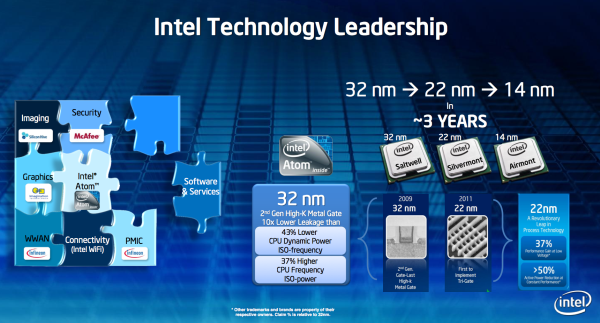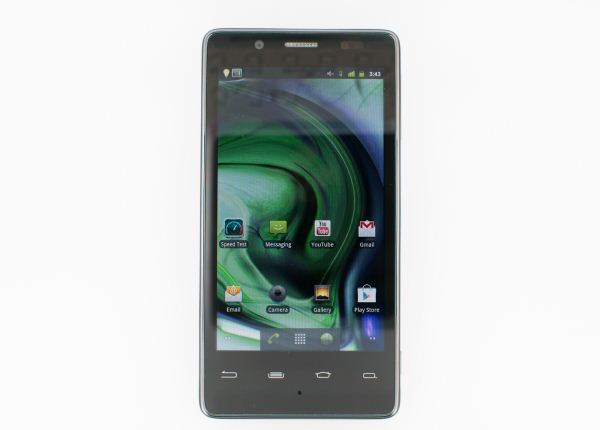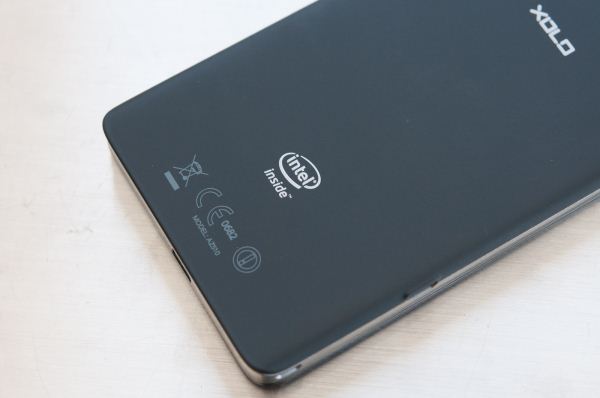Lava Xolo X900 Review - The First Intel Medfield Phone
by Brian Klug on April 25, 2012 6:00 AM ESTFor Intel, answering the looming ARM threat is obviously hugely important for the future, and it recognizes that - look no further than the restructuring of the Intel Architecture Group. The fire was lit with the impending arrival of Windows On ARM (WOA), at which point the line between traditional ARM-dominated smartphone/tablet SoCs and a real desktop class compute platform will start getting blurry, fast.
The other trend in the SoC space is slowly arranging all the pieces of the puzzle to truly deliver a complete System On Chip. In addition to CPU, GPU, and video encode/decode, those who will be the most successful and emerge as dominant players in the SoC space will need to bring baseband, GNSS, bluetooth, WLAN, and RF all onboard. Almost everyone gets that trend - Nvidia is adding baseband with Icera, Qualcomm has baseband and has added WLAN and Bluetooth with Atheros, Intel added baseband with Infineon and ISP with SiliconHive. Further, it has Gen graphics in the future for both GPU and video encode/decode. Look no further than the last slide of one of its slide decks and you'll see an illustration showing precisely what I'm talking about - pieces of the puzzle coming together.
We understand the motivation for building a smartphone SoC (computing is going even more mobile) and the integration necessary to get there (Intel owns a lot of IP blocks + Moore's Law), so how did Intel's first attempt fare? In short, reasonably well.
The Atom Z2460 in the X900 is a competent dual-core Cortex A9 competitor with competitive battery life and power draw, and no doubt Z2580 (its dual core, SGX544MP2 high end counterpart clearly targeted at Windows 8 platforms) will be equally as competitive against quad core A9s. If Intel's goal with both Medfield and the X900 was to establish a foothold in the smartphone SoC space and demonstrate that it can indeed deliver x86 in a smaller form factor and lower power profile than ever before then it truly is mission accomplished.
The x86 power myth is finally busted. While the X900 doesn't lead in battery life, it's competitive with the Galaxy S 2 and Galaxy Nexus. In terms of power efficiency, the phone is distinctly middle of the road - competitive with many of the OMAP 4 based devices on the market today. If you've been expecting the first x86 smartphone to end up at the bottom of every battery life chart, you'll be sorely disappointed.
There is however a big difference between middle of the road and industry leading, which is really the next step that we need to see from Intel. If Motorola is able to fit a 23% larger battery in a significantly thinner phone (Droid RAZR) then we need to see the same with Medfield. As Intel's major branded launch partner, we have high hopes that Motorola will deliver just that later this year.
The performance side is obviously even more competitive. Atom isn't always industry leading in our tests, but the X900 is rarely more than a couple places away from the top (with the exception of GPU performance of course, but that's a matter of licensing a different IP block in future versions). For a reference design that an Intel partner can just buy, barely customize, and ship - that's not bad at all. Smartphone vendors spend a considerable amount of time building phones that perform well - Intel's offer to internalize much of that can be either scary or amazing depending on who you're talking to.
There's always going to be room for design and software customization, but ultimately only those vendors who are good at those types of things will be able to survive if Intel's direct FFRD route succeeds. It's unsurprisingly very PC-like, where differentiation doesn't really happen at the motherboard level but rather at the system level. I can see both good and bad that could come of this, but the initial outcome should be positive. The results of this initial FFRD turned commercial device demonstrate that Intel is absolutely a competent system integrator itself, with an awesome display, camera, and other component choices.
The software compatibility story, like the concern over power consumption, is also a non-issue. The vast majority of apps we tried just worked, without any indication that we were running something intended for a different instruction set. There are still a few rough edges (e.g. Netflix), but if Intel is able to get things working this well at launch, the situation will only improve going forward.
Ultimately Intel's first smartphone is a foot in the door. It's what many said couldn't be done, and it's here now. What it isn't however is a flagship. To lead, Intel needs an updated Atom architecture, it needs to be on 22nm, and it needs a faster GPU - at a minimum. All of this needs to come in a reference design that's not just good enough, but better than the rest.
On the one hand it's a good thing that you can't tell an Intel smartphone apart from one running an ARM based SoC, on the other hand it does nothing to actually sell the Intel experience. Intel is never taken seriously in markets where it relies on being good enough, and it moves mountains in those where it's the best. That's what Intel needs to really build credibility in the smartphone space. A little was earned by getting this far, but its reputation will be made based on what happens next. There's obviously a strategy here, but I'm curious to see it unfold. Intel can be a fierce competitor in any space where it feels threatened. What I'm waiting for is that Conroe moment, but in a smartphone.
We waited years for Intel's first smartphone, now the question is how long do we have to wait for the first irresistable one?













106 Comments
View All Comments
vol7ron - Wednesday, April 25, 2012 - link
I doubt windows would expect PCI channels lol. Though, it might need drivers to operate.Everything you need is on the phone for windows to operate (Screen, CPU, Video, RAM and Disk space) exists, even though Windows doesn't require it all. Though, Windows does need some way to communicate with those devices (device drivers), which Win7/etc probably doesn't have.
Shadowmaster625 - Wednesday, April 25, 2012 - link
A few years from now it is likely I might be able to acquire one of these for dirt cheap. (Broken screen, etc) I would use it just for an ultra low power ultra low profile *single-function* pc. I would very much like to know if this hardware can run windows 7. It doesnt need to run well, it just needs to be able to go on the web and do basic things similar to an atom nettop.superPC - Wednesday, April 25, 2012 - link
it won't run windows 7. unlike windows 8, windows 7 requires standard RAM not LPDDR. windows 7 also requires some form of PCI.Musafir_86 - Wednesday, April 25, 2012 - link
-Excuse me, but IMHO, the type of physical RAM shouldn't matter. If not, we couldn't be able to load these OSes on VMs at all. :)Regards.
B3an - Thursday, April 26, 2012 - link
Why would you even want to run Win 7 on this when Win 8 would clearly be WAY better suited, not to mention it also uses less resources and RAM while remaining faster/snappier than 7.rahvin - Friday, April 27, 2012 - link
I'd imagine he wants to know because Windows 8 is going to be only slightly less successful than Vista. Personally I'd guess around 5% of the Vista sales. It's a disaster in waiting unless they make dramatic last minute changes. You should try using it.joshv - Wednesday, April 25, 2012 - link
I am not sure why this chipset matters. Intel usually wins on x86 compatibility with older software. In the phone space there is no existing x86 code, and in fact they are stuck emulating another ABI - so they will be slower and less efficient that competitors that implement that ABI natively.That leaves Intel to compete on price/performance alone in a market where their competitors have 99.9% of the market. An odd position for Intel.
Perhaps this makes more sense in a Windows 8 tablet?
Impulses - Wednesday, April 25, 2012 - link
Its netbooks all over again, on a much bigger scale. ARM is moving upscale, if Intel doesn't start competing directly they will eventually start ceding some existing market share (when tablets/laptops start to overlap more, and the writing's on the wall with Windows for ARM).Only difference is they're up against a capable rival(s) as opposed to a limping AMD, so they can't just come out of the gate strong and them dog it and let the lower end market stagnate in order to maintain profits.
This is a small first step but it'll allow them to ink more deals and possibly cement a strong foundation for upcoming Win8 ARM tablets which is probably their bigger long term concern.
dcollins - Wednesday, April 25, 2012 - link
Did you even read the article?The x86 vs ARM issue is mostly a non-issue that will be completely resolved within a few months. Dalvik apps are JIT compiled to ARM and x86 and will perform similarly. In fact Intel might have an advantage here because they have the best compiler engineers in the world with decades of experience in generating high performance x86 code. NDK apps will generally be supported natively; developers only have to check a box to include x86 binaries. Even Apps that aren't compiled with x86 support are translated prior to installation on the users device. Nothing about the instruction set makes Medfield slower than ARM.
Performance today is comparable to modern ARM processors even when running an out of date, slower OS. Performance in 4.0.x should match or outperform even Krait. Graphics performance is middle of the road, but that's a major concern for many smartphone buyers (myself included). Even in benchmarks that purposefully stress mutliple cores, Medfield holds its own against the many cored competitors. Real world usage is more lightly threaded.
Browser performance is the most important metric for my usage and here Intel performs extremely well. If Medfield is available in a 4.x phone when it comes time for me to upgrade, I will seriously consider it versus a Krait based offering. Now imagine a next generation Atom build on 22nm with dual core, hyperthreading and possibly OoO execution: that chip will eat A15s for breakfast.
dcollins - Wednesday, April 25, 2012 - link
edit: "Graphics performances... is NOT a major concern"